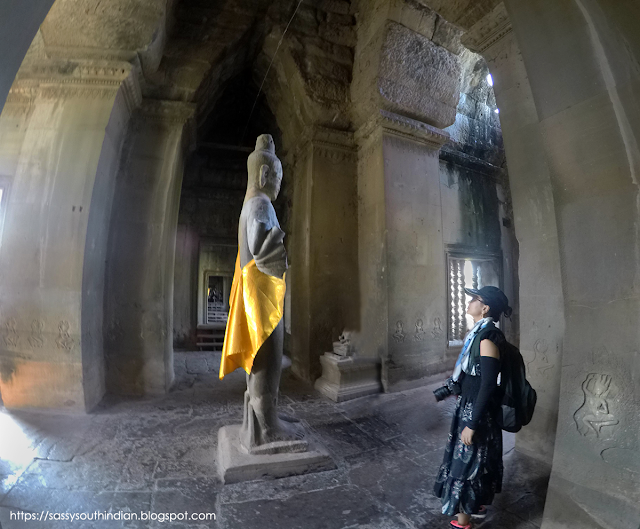‘Art and architecture are like creative discoveries, they speak for themselves’
At the heart of all megalith structures, lies a true and beautiful meaning behind its existence and purpose. Angkor Wat is one such architectural marvel that leaves you spell bound not just for its size but for some of the rarest representation of life a mere 1000 years ago.
Built by King Suryavarman II in the 12th century as a vast funerary temple that would hold his remains, symbolically confirming his permanent identity with Lord Vishnu – and has sculpted walls that speaks in volumes about the two incarnations of Lord Vishnu as per the Indian Mythology.
The huge structure of Angkor Wat is the best representation of classical style of Khmer architecture and ebbs an aura of divinity that can be found in religious holy shrines.
Built by King Suryavarman II in the 12th century as a vast funerary temple that would hold his remains, symbolically confirming his permanent identity with Lord Vishnu – and has sculpted walls that speaks in volumes about the two incarnations of Lord Vishnu as per the Indian Mythology.
The huge structure of Angkor Wat is the best representation of classical style of Khmer architecture and ebbs an aura of divinity that can be found in religious holy shrines.
Although, it’s a challenge to find pathways at Angkor empty, one gets to see the beauty of the never ending long structure through these mega passages. The temple of angkorwat has series of arched inner temple hallways like these throughout the temple's various levels. The stone on the sidewalls are completely covered with beautiful carvings - depicting the ancient workforms of the Mahabharatha and the Ramayana era.
The many theories of why Angkor was built?
There is not one but multiple theories as to why this megalith temple construction was considered. Let’s try and get some light onto this,as per some experts across the world - both the layout of the Angkor temples and the iconographic nature of much its sculpture, particularly the asuras ('demons') and devas ('deities') sculpted intricately on the walls of the temples are also intended to indicate the celestial phenomenon of the precession of the equinoxes and the slow transition from one astrological age to another.
Conventional theories presume the lands where Angkor stands were chosen as a settlement site because of their strategic military position and agricultural potential. Alternative scholars, however, believe the geographical location of the Angkor complex and the arrangement of its temples was based on a planet-spanning sacred geography from archaic times as per scaredsites. Using computer simulations, it has been shown that the ground plan of the Angkor complex – the terrestrial placement of its principal temples - mirrors the stars in the constellation of Draco at the time of spring equinox in 10,500 BC. While the date of this astronomical alignment is far earlier than any known construction at Angkor, it appears that its purpose was to architecturally mirror the heavens in order to assist in the harmonization of the earth and the stars.
Manifold uniqueness of Angkor
As early as 12th century the current monument was standing on what was then known as ‘Yasodharapura’ and unlike any other temples in the same area facing east – Angkor specifically is aligned to the west, giving a spectacular sunset view ! The temple complex is a representation of classical style of Khmer architecture with five central shrines , having three levels constructed at various dimensions with moats and gigantic compounds surrounding the built city complex. The western exterior or the extended compound area has forecourts of the main temple contains two libraries or smaller temple structures, which also served as ‘astronomical observatories’.
The Khmer's, adhered to the Indian belief that a temple must be built according to a mathematical system in order for it to function in harmony with the universe. Distances between certain architectural elements of the temple reflect numbers related to Indian mythology and cosmology.
Orthodox archaeologists sometimes interpret the temples of the Angkor complex as tombs of megalomaniacal kings - yet in reality those kings designed and constructed the temples as a form of service to both god and their own subjects as per a few sacred sites. The temples were places not for the worship of the kings but rather for the worship of god. The sacred sanctum, is housed nearly in the middle of the last level of the temple complex and one can be enter this area only at scheduled times and in appropriate dressing as directed by the guards. A steep climb and you can see the spectacular view of the levels below. It houses large figurines mostly disfigured and some restored (possibly the main deity of those times).
The main sanctum is precisely aligned with the stars, constructed as a vast three dimensional yantras and adorned with stunningly beautiful religious art, the Angkor temples were instruments for assisting humans in their realization of the divine.
The site receives more than 2 million visitors annually during peak seasons –for Angkor Wat is a sight to behold.
Wait for my equally intriguing photo stories on Angkor Thom, the Bayon Temple complexes as well..!
Have you visited this place? Share your experience !
P.S. Please note that all information are a part of history behind the temple mythology (not mine) and the information may differ based on different perspectives and narratives as the information is a reference from various sources online. I am presenting here my understanding and perspective of the same in a condensed format to keep the blog short and interesting
You could comment below if you wish to know more in detail about any specific details/ photographs mentioned.








No comments:
Post a Comment